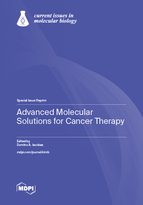Advanced Molecular Solutions for Cancer Therapy
A special issue of Current Issues in Molecular Biology (ISSN 1467-3045). This special issue belongs to the section "Molecular Medicine".
Deadline for manuscript submissions: closed (31 December 2023) | Viewed by 39402
Special Issue Editor
Interests: cancer therapy; cancer biomarker; neurogenomics; systems biology; intercellular communication; neurotransmission
Special Issues, Collections and Topics in MDPI journals
Special Issue Information
Dear Colleagues,
Identifying the most effective actionable molecules whose “smart” manipulation might selectively kill, slow down, or stop the proliferation of cancer cells, with few side effects on the normal cells of tissue, was, for decades, one major objective of countless investigators. For a long while it was (and still is) believed that restoring the normal status of selected biomarker genes (whose mutations or/and altered expressions are responsible for triggering cancerization) was the solution. The problem is that, according to the 36.0/12/12/2022 release of the NIH-NCI Harmonized Cancer Datasets (https://portal.gdc.cancer.gov/), almost every gene was found to be mutated in cases of almost every form of cancer, and every form of cancer exhibited mutations in almost all genes. Moreover, together with the blamed biomarkers, the expressions of hundreds of other genes appear as regulated when tissues from cancer patients and healthy persons are compared. Nonetheless, tumors are heterogeneous, harboring cell subpopulations with distinct genotypes and phenotypes, requiring the referral of cancer clones to normal cells of the same tissue in each cancer-affected human. This Special Issue, a continuation of “Molecules at play in cancer” (https://www.mdpi.com/journal/cimb/special_issues/molecules_cancer), aims to present the latest developments in molecular solutions for cancer therapy, as well as the ways through which to personalize treatment to the individual characteristics of patients.
Dr. Dumitru A. Iacobas
Guest Editor
Manuscript Submission Information
Manuscripts should be submitted online at www.mdpi.com by registering and logging in to this website. Once you are registered, click here to go to the submission form. Manuscripts can be submitted until the deadline. All submissions that pass pre-check are peer-reviewed. Accepted papers will be published continuously in the journal (as soon as accepted) and will be listed together on the special issue website. Research articles, review articles as well as short communications are invited. For planned papers, a title and short abstract (about 100 words) can be sent to the Editorial Office for announcement on this website.
Submitted manuscripts should not have been published previously, nor be under consideration for publication elsewhere (except conference proceedings papers). All manuscripts are thoroughly refereed through a single-blind peer-review process. A guide for authors and other relevant information for submission of manuscripts is available on the Instructions for Authors page. Current Issues in Molecular Biology is an international peer-reviewed open access monthly journal published by MDPI.
Please visit the Instructions for Authors page before submitting a manuscript. The Article Processing Charge (APC) for publication in this open access journal is 2200 CHF (Swiss Francs). Submitted papers should be well formatted and use good English. Authors may use MDPI's English editing service prior to publication or during author revisions.
Keywords
- cancer biomarker, cancer clone
- cancer functional pathway
- cancer gene therapy
- cancer master regulator
- cancer stem cell theory
- cancer targeted therapy
- cancer immunotherapy
- cancer personalized therapy







